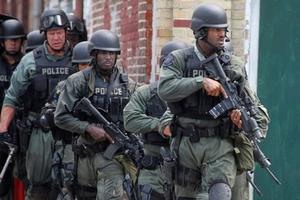Law enforcement technologyDHS-funded police gear blurs line between crime-fighting and war-fighting
DHS is funding the purchase of military gear by Bay Area police departments. Critics of the program say the money allocated for the war on terror is blurring the line between local law enforcement focusing on crime fighting and soldiers fighting in an enemy war zone.

Critics decry what they see as the militarization of the policing function // Source: zohur.net
When Alameda County, California, Sheriff Greg Ahern tried to buy a drone for his police force, privacy advocates were quick to express their objections in a Board of Supervisors agenda meeting late last year. The sheriff’s plan was put on hold.
This did not stop the San Mateo County’s Office of Emergency Services from requesting $70,000 for a drone. In San Francisco, law enforcement agencies tried to purchase a drone as well, but their $100,000 request is still pending. The same goes for San Jose’s bomb squad, which put in an $8,000 request.
Contra Costa Times reports that most of the requests did not encounter opposition because the money being spent was federal funds that DHS gives to cities the department considers to be a high risk for a terrorist attacks. For the drones, the money came from the Urban Areas Security Initiative (USAI), which gave $26 million to the Bay Area to equip localities there with night vision goggles, remote-controlled robots, surveillance cameras, license plate readers, and armored vehicles which resemble unarmed tanks.
Since 2003, the Bay Area’s USAI has given $359 million in DHS funds to agencies from twelve Northern California counties. In addition to the drone, San Mateo County also requested a license plate reader and a system for destroying IEDs.
To receive funding for equipment, the proposals have to have an anti-terrorism purpose. The area contains many targets – among them the Golden Gate Bridge, Shell Oil Refinery, Lawrence Livermore Lab, and Bay Area Rapid Transit – which are considered as prime terrorist targets on the west coast.
The agencies, however, are also using the money for staff, training, outreach, and military-grade equipment for law enforcement.
“We try to prepare our community for any disaster,” Craig Dziedzic, Bay Area UASI general manager, told the Times. “The top priority is still to protect the community. That hasn’t changed at all. … But in order to be funded, you need a nexus to terrorism.”
Critics of the program say the money allocated for the war on terror is blurring the line between local law enforcement focusing on crime fighting and soldiers fighting in an enemy war zone.
As far back as seven years ago, former San Jose police chief Joseph McNamara expressed his discomfort with this lack of clearer distinction between law enforcement and war fighting.
“Simply put, the police culture in our country has changed,” he wrote in the Wall Street Journal in 2006. “An emphasis on ‘officer safety’ and paramilitary training pervades today’s policing,” he continued, “in contrast to the older culture, which held that cops didn’t shoot until they were about to be shot or stabbed.”
Last month the American Civil Liberties Union (ACLU) started an investigation into police use of military technology.
“We want the police to keep up with the latest technology. That’s critical,” ACLU Senior Counsel Kara Dansky told the Times. “But policing should be about protection, not combat.”
The Fremont Police Department requested an armored vehicle and the Oakland Police Department asked for a portable surveillance camera in order to gather information and intelligence on potential terrorists on their activities.
Sheriff Ahern responded to the criticisms by saying that local law enforcement is working to adopt the equipment and tactics of the military, which includes Urban Shield Training, by putting police through drills which resemble military operations.
Ahern added that the USAI program gives small agencies access to equipment they would otherwise never be able to purchase because of budget shortfalls. Law enforcement and the communities they serve are safer because of it, he said.
